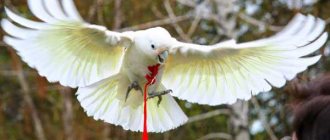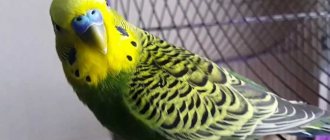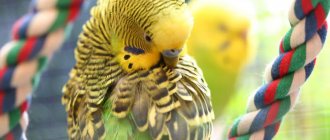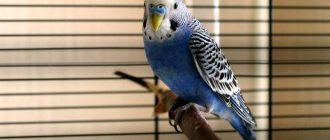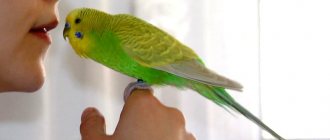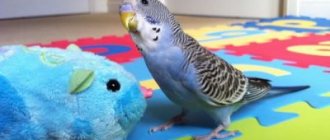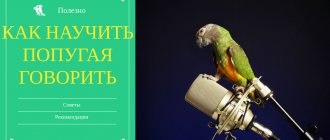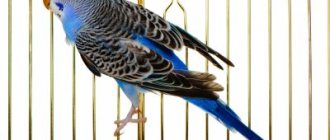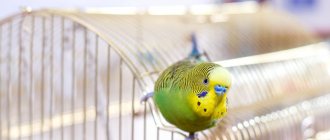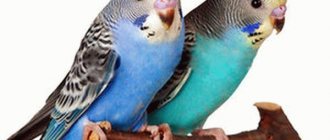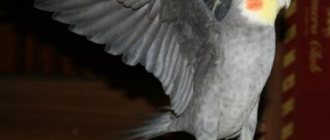Home » Other animals
Parrots occupy an important place among pets. They require special conditions of detention; communication with them is radically different from contact with other animals. But the main nuance is the ability of most breeds to imitate sounds. A cockatiel parrot can be taught not only melodies or whistles, but also human speech, which will make being with a colorful pet even more exciting.
- 2 How to teach a cockatiel parrot to talk and sing
- 3 Training programs
- 4 Video: how to teach a cockatiel parrot to talk
Military bearing: a parrot marches across the floor
Parrots are cute and intelligent birds that can entertain their owners with tricks or conversation.
But some of them discover completely unexpected talents. A video of a marching parrot from Japan appeared on YouTube in August 2021. It quickly gained a huge number of views and went viral - everyone liked the brave bird with a military bearing. There are two versions of the video - full and cropped. In the original, the parrot behaves quite strangely at first - it lies on its back and pecks at the floor. Apparently he just doesn't know what to do. But then the bird cheered up and decided to march. The parrot began to stomp around the room, throwing its paws high.
Making a ladder
For a parrot of any species, there is nothing more interesting than going up and down stairs. They are sold in huge quantities and variety in all pet stores, but the most correct thing would be to make a ladder with your own hands. To do this you need to do the following:
- Take several sticks of the same size. Under no circumstances use branches of bird cherry, poplar, pear, or oak.
- Cut notches along the edges of the sticks.
- Sand the sticks to a smooth surface.
- Tie a ladder from rope or elastic and attach it to the cage.
Video: parrot stomps on the floor (full version)
It really does look like a drill step. Perhaps the bird is dreaming of a military career. Although netizens have other explanations.
When you ordered pizza and are waiting for the courier.
Tanya Mills
www. youtube.com/embed/nr3W5jGSs8o
He sat on a perch in the cage, so he does gymnastics, stretched while lying down, stretched out his paws, and then jogged.
Alexandra Patrueva
www. youtube. com/embed/nr3W5jGSs8https8о
This parrot parodies the owner, who enters the door and strides importantly around the apartment. He first looked under the door: “Master, where are you? Netuti? Well, then I'm for him. »
Ternecia
https://pikabu.ru/story/zabavnyiy_popugay_4762994
Features and character of a parrot
Cockatiels are mischievous and sociable parrots, they are so popular for home breeding because of their pleasant appearance. In addition, buyers are attracted by the ability of these parrots to imitate human speech. Each bird has individual abilities, and it is impossible to determine at first glance whether it will be able to repeat words or will just chirp. Do not think that the cockatiel speaks clearly, like a macaw or a gray coat. The vocal apparatus of the crested parrot does not allow it to clearly articulate sounds, so the spoken words only vaguely resemble the original.
It is easier to teach a grown-up chick older than two months to talk. An adult has established habits, her mind is not so mobile, so her studies will be difficult and sometimes unsuccessful. If you want to buy a parrot capable of learning words, look not at color, but at behavior. The talented bird is not silent, ruffled, but jumps and chirps. In the voice of the gifted parrot you can hear different notes, whistling and singing. Even if he cannot pronounce human words, he will successfully cope with copying environmental noises: the hum of household appliances, the barking of a dog, the howling of a car alarm.
Video: Parrot Marching (cropped version)
By the way, the bird belongs to the red-headed caique species. By nature, these are very active birds, so it is not surprising that the parrot has nowhere to put its energy.
Another name for the red-headed caique is the red-headed white-bellied parrot.
If you hear stomping overhead, don't rush to blame your neighbors - it might be their parrot marching. What can surprise your pets? Share your funny observations in the comments!
Source
When do birds start laying their first eggs?
If a beginner decides to start breeding wavy fish, then he must be patient with this process, which is divided into several stages:
Initially, you need to choose the right pair so that a trusting and warm relationship is formed between the birds;- the courtship period can even last several months;
- if the female allows the male, then from the moment of mating until the appearance of the first egg, approximately 10 days pass;
- the owner can easily understand when the egg-laying process begins, since the female begins to push away the male, often retreats into the house, and her tail periodically shakes and her breathing becomes heavier;
- before laying itself, the bird plucks its feathers;
- eggs appear daily or every other day, and in young females their number is much greater than in mature birds.
The female does not always begin to warm the eggs immediately, so the incubation process may begin after a few days.
How to understand a parrot: bird gestures
First of all, let's deal with such a distinctive feature as the crest (in those varieties of parrots that do not have it, everything that is said below applies to simple feathers on the head). So, if the crest “looks” back, the bird is calm. If the crest is pressed, the parrot presses its head into its shoulders and chirps - this is a submission pose (usually used in a pair of male and female).
If the crest sticks out on the top of the head, the parrot is interested or surprised. A frightened bird differs from an interested one in that it stretches out straight and presses all its feathers tightly to its body. If at the same time the parrot extends its head and opens its beak, it is trying to scare and drive away, and also warns that it will bite.
A parrot may look ruffled if it is about to sleep or is already dozing. He may also be cold or irritated by something. In the latter case, he will look really unhappy. A parrot can thus express antipathy both towards its relatives and towards a person (for example, towards an unfamiliar guest). Sometimes a parrot may have this appearance during molting.
If the parrot sits ruffled, sleeps all the time on a swing or perch, and has lost its appetite, this may indicate a disease of the internal organs. But if the droppings are normal and there is no discharge from the nostrils, the parrot is simply moping (although who said that depression is not dangerous?) Or the bird, like a small child, is trying to attract your attention in this way (if you have not communicated with it for a long time or disrupted her regime).
The parrots also spread their wings when singing (courtship) - this time completely, to demonstrate the beauty of each feather. And this applies, of course, only to males. They are literally the “fair sex” in the world of birds: males have a set of XX chromosomes, while females have a “male” (in our understanding) set of XY. This is what makes females more aggressive, less tame and sociable, and they do not have any special talent for remembering words.
If, while yawning, a parrot puffs up its feathers around its beak, then it really wants to please you! This is how the bird shows how harmless it is: it doesn’t even have a sharp beak! In general, in our understanding, it is a typically “female” trick.
The pinnacle of bird trust is a request to scratch the neck (but only it, it is better not to touch the rest of the body, as this irritates even the most affectionate and tame birds). In this case, the parrot tilts its head forward, pushes its hand with its forehead, after squeezing with its beak or chirping.
If the parrot is excited, it shakes its head strongly up and down and knocks its beak on what it is sitting on: a perch, cage, etc. Walks from side to side, shifting, or jumping. If at the same time the parrot “smiles” (opens its beak) - it enjoys life. Sometimes excited behavior can mean that a pet needs a mate: the displaying male makes calling sounds, knocks his beak on the bars of the cage, raises the feathers on his head, thus trying to attract a female.
A parrot can press its paw: if it is clenched into a fist and raised up when it is resting or when communicating with you, this indicates its good health and trust, a feeling of complete security.
Always be alert as parrots have a habit of masking when they are feeling unwell. This is partly due to the fact that a female can beat a male to death if she instinctively feels that he is not suitable for breeding. This, by the way, is one of the reasons why you need to put your parrot in another cage at the first signs of illness.
Attention and inattention
If a parrot tilts its head to the side, it is listening to you with interest. But if you start talking, and he starts absentmindedly eating or preening his feathers, then most likely he doesn’t know how to react to you (perhaps he harbors a grudge against something and ignores it).
If a parrot rummages aimlessly in a feeder and throws out food, this is also a kind of demonstration of “freedom for parrots!” This behavior is often typical for young chicks when they are “torn off” from their parents and placed in another cage. If your parrot behaves this way, then most likely it was sold very young and was not fully cage trained. Over time, of course, he will adapt - but he really needs your friendship and attention.
Similar behavior is also characteristic of some “paired” species of parrots if they are kept alone. Their psyche is not adapted to this. Therefore, such a “bird” breaks out of the cage to fly away and find a relative. Sometimes the feeder is swung with such force that the lid comes off the base, which is very dangerous (the parrot can get free without your supervision). In the latter case, it is better to let your pet out for walks more often and think about buying him a pair.
Related articles: window in a home sauna
Source
Other vocalizations
Like singing, babbling and whistling, parrots have many other sounds in their repertoire, including gentle, soft growls and tongue clicks. A parrot's muffled growl is somewhat similar to the purring of a cat or dog wagging its tail, in that it tends to sound content, but not to be confused with the louder, more menacing growls that some species of parrots make when irritated. or dissatisfied, which is pronounced as a warning signal.
Tapping the tongue usually indicates that the parrot is interested in something or is trying to get attention to tickle itself or get out of the cage.
Why does the parrot sit at the bottom of the cage, ruffled, with his eyes closed?
Bustling activity, cheerful chirping and constant mischief - this is all about the domestic budgie. We are accustomed to considering wavy fish as real live creatures. And if it suddenly happens that the parrot is sitting at the bottom of the cage, ruffled and with its eyes closed, this is a cause for concern. Why doesn't the bird fly or sit on a perch? This can be explained by observing the pet for some time. Let's consider several possible options.
Artificial friend
Parrots are very sociable creatures. If you have only one bird, then she definitely needs an object with which she can “talk”. It can be a mask or a toy parrot, which is easy to find in any pet store. They can be made of various materials (plastic, wood, etc.) and have a variety of sizes. When purchasing a wooden “friend,” make sure that the parrot’s wood is not painted with varnish or any other similar product. If you take a plastic bird, check if there are any traces of glue left on the toy.
If you have certain skills in needlework, then you can sew such a toy yourself. This craft will be environmentally friendly and will definitely not harm your pet.
Poisoning
The decrease in activity occurs as a result of poisoning - the parrot may swallow something dangerous or inhale toxic fumes. Parrots are very curious, they strive to bite and try surrounding objects. You cannot leave your pet unattended during a walk, otherwise he will definitely get into trouble. A poisoned parrot quickly loses strength, sinks to the bottom of the cage and sits with its eyes closed, ruffled, not reacting to external stimuli.
Poisoning in a parrot
The risk of household poisoning contains:
Note! A parrot can become poisoned when it chews on a low-quality toy. Pieces of plastic entering the stomach begin to release toxins into the body.
In the best case, the bird experiences a mild intestinal upset after poisoning and recovers quickly. Severe toxic damage deprives the bird of strength and will to live. This is accompanied by such striking symptoms as diarrhea, vomiting, and cramps. An exhausted parrot lies at the bottom of the cage and trembles. If you do not provide assistance to your ward in a timely manner, he will die.
Safety regulations
When making toys with your own hands, it is important to know how not to harm your feathered friend. To do this, you should follow a few simple rules:
- Make all holes of such a diameter that the parrot's beak cannot get stuck in them. It would be ideal if the beak does not fit into them at all.
- Use less paint in your creations. This will protect the parrot from poisoning.
- Use only durable materials in your crafts. A parrot can chew and swallow a fragile product.
- Do not use materials that are toxic to the parrot: zinc, copper, brass, etc.
- Don't make rope out of cotton. When disheveled, they can enter the bird’s body and clog the stomach.
- For your products, use only branches and twigs of fruit trees. In other cases, there is a risk of poultry poisoning.
Parrots are cheerful and curious creatures. By enriching their lives with a variety of toys, you will make them healthier and happier. For this, parrots will diversify your life and help you become a little kinder and more cheerful.
Originally posted 2018-03-19 10:05:24.
Colds
No matter how strange it may sound, domestic parrots, even though they are in “greenhouse” conditions, are more likely to catch a cold than free birds. When kept indoors, fragile pets react more strongly to changes in temperature and humidity and are very afraid of drafts. An open window in hot summer weather is one of the common causes of colds.
Many parrots love to bathe and get this opportunity quite often. However, after water treatments, the bird does not always have time to dry, especially in a cool room, so it catches a cold.
Sneezing is accompanied by discharge from the nostrils; in addition, the parrot feels itching in the respiratory tract and often scratches the wax with its claws. The body temperature rises, trembling appears, the bird tries to warm up and hides its beak in its feathers. The general condition is deteriorating, which affects activity: the feathered pet does not fly or jump, but sits in the corner of the cage, huddled into a ball, conserving energy.
Easy ways to teach a parrot to talk
It is worth choosing a few words that are easy for the bird to repeat daily with expression 10-20 times per lesson. In addition, use them as often as possible in everyday life. This way the parrot will learn its lessons faster.
Teaching a bird to talk using a voice recorder
In order to teach your pet human speech, you need systematicity and time. Many breeders use recorded lessons.
But there is one important condition. The person must be in the same room at this moment. Otherwise, the bird will get used to talking only to itself, and the owners will not have the opportunity to appreciate its excellent skills.
Necklace parrot talking and petting 2
Desire to breed
Owners of ornamental birds sometimes observe strange behavior in their charges: the parrot sits for a long time at the bottom of the cage in the corner, and then shakes itself off and flies up onto a perch. You can't tell from his appearance that there is any cause for concern. Such actions suggest the idea: the parrot is preparing for procreation.
If a different-sex couple lives in a cage, it is quite possible that this is how the beginning of nesting manifests itself. It is recommended to support the instincts of pets: set up a nest box for them. But if the only inhabitant in your home’s living area is a female parrot, you need to suppress her desire for offspring. You should remove the mirror, twigs, and paper from the cage. There should be no materials inside from which the bird could build a nest. False incubation must be stopped, otherwise the parrot will lose its health in vain.
How to create a simulator
The easiest way to make a simulator for your pet will be using a plastic bottle and wooden sticks.
The process of creating a simulator consists of the following steps:
- We cut a tube-shaped blank from the bottle, leaving the bottom.
- We drill holes in the bottle and insert wooden sticks into them.
- Fill the bottle with washed and calcined sand.
Such a simulator will help the bird lose weight and help maintain its health for many years.
Improper feeding
The budgerigar is an active bird, constantly on the move. A healthy parrot jumps from branch to branch, walks along the bottom and pecks grains, tears paper, but it will not sit on the floor of the cage. Then it is not entirely clear why the parrot suddenly began to spend a lot of time below. Probably his paws get tired of clinging to the perch, and it’s more comfortable to sit on the pallet. The reason for this condition is errors in nutrition: excess fatty foods or lack of nutrients.
Obesity in a parrot
You need to feed your pet not on demand, but on time, observing the portion size. If you do not adhere to dietary standards, the parrot will get used to overeating, due to which it will gain excess weight. A heavy body is a load on the legs and wings. An obese bird has difficulty moving and simply feels discomfort.
Monotonous food
On a note! It should also be noted that starvation is one of the reasons for bird weakness. The food may be of poor quality, and the parrot will not get enough of it. In some cases, exhaustion is caused by switching to another food that the pet does not like.
Adaptation of a parrot in the house (after purchase)
Adaptation of a bird from the moment of arrival to a new home lasts on average 1-3 weeks. The specific meaning depends on the nature of the bird and its other individual characteristics. It is important to support all family members during this period. Therefore, in the first days it is better to leave the bird in peace and put the cage in a quiet place. Thanks to this, the bird calms down and adapts.
Interesting! If an animal accidentally cables from its cage, there are many ways to put them in it without disturbing its nervous system. During the adaptation period, it is important to establish complete trust between Cirrus and the owner.
The following symptoms are sometimes observed during this period:
Important! The nervous system of these birds is quite sensitive. During removal, the animal experiences great stress and even breaks the feathers on its body. This is why the owner must assist in the transition of the adjustment period.
Illness or injury
If a wavy sits or lies on its belly at the bottom of the cage and breathes heavily, this is an alarming signal. Most likely, this behavior indicates a disease. Avian diseases are more common in parrots that are kept in pairs or flocks. Lonely pets also suffer from infectious diseases, parasitic infestations, joint diseases and metabolic disorders.
The bird cannot sit on a perch in a cage; it lies on its stomach when one or both legs are damaged. These could be ulcers on the soles, gout, arthrosis or other pathologies. A budgerigar has very fragile limbs, and it can easily get injured: a dislocation, a fracture, or a claw being torn off. During free range, young birds often crash into mirrors, glass, furniture, and this is fraught with concussion and rupture of internal organs. If the parrot is ruffled and has closed its eyes, but is not sleeping, you need to examine it. If you notice an unnatural position of the limbs or beak, contact your veterinarian.
Next, we’ll look at options on how you can cope with your pet’s painful condition on your own.
Unusual behavior as a signal of illness
Sometimes a bird can open its beak, but there is no sound. And this is repeated several times in a row. In this way, the birds clear their throats from descending. It can also be caused by jammed food. But fear not, a pet can easily overcome this problem.
But this behavior is typical in the case of a tick infection of the trachea. In this case, a decrease in appetite, drowsiness of the bird and a decrease in activity are added. The parrot does not fly out of the cage, indifferent to the delicacies and attention of the owner. Such reasons require urgent referral to a veterinarian.
Important! Symptoms are also dangerous when the bird does not want to leave the cage, only sits and breathes with its beak open. They are characteristic of respiratory diseases and require immediate veterinary attention.
Sitting and hiding the head under the wing when not sleeping normally also indicates health problems. This behavior may be accompanied by a refusal to eat, weakness, apathy and breathing difficulties. Sometimes the parrot is scratched hard, and the feathers are said to be on the back, suggesting that they are formed, and there is a drop in weight.
To recognize a bird's bad mood or the onset of illness, the owner must know the body of speech of these birds. Behavior can be used to "read" a bird's mood, its wants and needs, signals of poor health, and many others.
Treatment
Every owner should be able to provide first aid to a feathered pet. If you have a cold, it is enough to warm the parrot (turn on an infrared lamp near the cage) and drink it with chamomile infusion.
Poisoning is of particular concern: small parrots have a very fast metabolism. Toxins that enter the body instantly penetrate all systems. A ruffled parrot with its eyes closed involuntarily shows that it needs urgent treatment. Sometimes the hours count.
The procedure for eliminating intoxication:
A parrot crests under different circumstances, and this should not always cause concern. But if the bird tries to hide in the corner of the cage and lies on its stomach, you cannot leave it without attention. There are several reasons for this behavior: poisoning, illness, injury. After the first symptoms are removed and the parrot’s condition is alleviated, you need to show it to a veterinarian.
Source
Feathers and stand
A parrot losing feathers may simply be going through a moult, but if your parrot seems a little cuddly and unsociable and is not associated with the molt, it could be a sign of stress and unhappiness. A parrot that plucks its feathers, in addition to regular grooming, is also showing signs of stress and unhappiness.
Your parrot's body language and the way they hold their feathers can also tell you too much about them, and if your bird appears curled up in a ball with fluffy feathers (which stay that way and are not part of grooming, training and stretching), they can't be healthy or happy.
For parrot species with a cockatoo-like crest, the position of the crest can be very revealing. They may raise the comb out of interest or happiness, but if they raise the comb and are accompanied by a tense posture or signs of unhappiness, it may be a warning and protection.
Important information
What should you do if your budgie is afraid and is very afraid of your hands? No need to be upset. The main thing is don’t worry. It is normal that poultry does not immediately get used to its new owner. After all, no one has canceled the instinct of self-preservation. If you do everything right, begin to apply our practical advice, over time the fear will pass and you will establish contact with her.
Related articles: roof chimney lining
First of all, the bird must get used to its new place of residence. After you have bought and brought her to your home, you should not immediately run and impose your communication on her. The biggest mistake is if you stick your hands into the cage to catch the bird. It is because of this that difficulties often arise with taming birds. After all, after such actions, their psyche seriously suffers. At this time, everything around is unknown to the parrot, he is afraid of everything, and then you climb towards him with your hands. You will still have plenty of time to establish relationships and become friends. In the meantime, let the pet gradually and calmly adapt to the new conditions.
Patience is something you will never be able to do without! The fact is that the process of properly taming a budgie to your hands so that it stops being afraid of them can take a lot of time and effort.
Friendship must begin with trust. The budgie should feel safe, only after that it will begin to get used to your hands, then you can quickly accustom it. Once again - only after establishing a trusting relationship is successful training possible! To do this, you also need to keep the following points in mind:
the bird needs time to adapt; Each pet is unique, has its own unique characteristics and needs; you must act in the right way; classes should be conducted regularly.
There is more than one way to make a tame bird out of a parrot and teach it to sit on your hand. Someone even writes how to tame a wavy dog in a minute or 5 minutes. But such techniques have many negative consequences. We have chosen the most effective and uncomplicated method for quite quickly, in our opinion, and at the same time calmly accustoming a budgie (no matter a boy or a girl) to your hands, so that he is not afraid of you. This is what you and I will consider and apply in practice.
DIY parrot ladder
Pet parrots are very popular pets: they do not take up much space in the apartment and bring great joy to their owners, especially children. To diversify the lives of birds, many owners equip their homes with various toys: bells, mirrors, hanging swings and ladders. All these items are available in abundance in specialized stores, but it’s nice to make something for your pet with your own hands - for example, a ladder. The article will discuss how to make this accessory with your own hands.
Why do you need a ladder for a parrot?
Parrots like a kind of “sports equipment” that allows them to release their energy. For example, they are very fond of ladders, which contribute to the training and development of birds and encourage them to be physically active.
How to make a ladder with your own hands
Making bird fun of this kind will not be difficult and will not take much of your time.
Important! It is necessary to collect natural material to make toys for a parrot away from busy roads, since trees growing along the highway pose a danger to your pet: they actively absorb all the exhaust from cars, which can have a detrimental effect on its health and life.
What trees are they made from?
It is very important to know which types of trees can be used to make an entertainment ladder for a parrot, and which ones are absolutely not suitable for this.
Can be used:
- birch,
- cherry,
- apricot,
- grape,
- viburnum,
- linden,
- maple,
- aspen,
- sea buckthorn,
- raspberries,
- rowan,
- hazel,
- plum,
- apple tree
- cherries,
- chokeberry,
- currants
It is unacceptable to use:
- elderberry
- oak,
- pear,
- lilac,
- acacia,
- bird cherry,
- poplar,
- ash,
- a coffee tree,
- all types of coniferous trees.
In general, any wood that contains tannins or pine resin is prohibited.
Tools and materials
The work will require the following materials and tools:
- long sticks (about 40 cm) made of approved wood, such as maple;
- short sticks (10 cm) made of wood of a contrasting color (birch);
- plastic clamps for fastening;
- gardening scissors;
- stationery knife;
- stationery scissors;
- old toothbrush;
- container for soaking sticks;
- emery cloth;
- pencil;
- ruler.
Manufacturing process
Step-by-step instructions for making an entertainment ladder:
- Cut branches from trees using garden shears.
- Rinse each branch from dust and dirt under running water.
- Soak the material for 2–5 hours, completely immersing it under water: this will help destroy pathogenic bacteria and parasites.
- Carefully clean each branch with an old toothbrush.
- Pour boiling water over the preparations.
- Dry the material.
- Choose sticks of suitable thickness (1.5–2 cm).
- Trim each branch with a utility knife to the desired length, leaving two long ones and several short ones.
- Sand the edges of each cut with sandpaper.
- Using a pencil and a ruler, measure the same distance (5 cm each) on the two long sides of the future ladder to place the crossbars.
- Place the crossbars on each side panel one by one and secure them with plastic clamps.
- Use scissors to cut off the protruding tails from the clamps, making sure that there are no sharp cuts.
- Install the ladder in the selected location in the bird’s home, attaching it to the rods or to the main crossbar in the cage with clamps.
Important! It is prohibited to treat handmade bird toys with paints and varnishes due to their toxicity.
Video: how to make a ladder for a parrot
Safety regulations
All objects that surround the parrot must be absolutely harmless.
Here are some safety rules to remember:
- It is unacceptable for handmade products to have sharp or prickly edges.
- Stairs for pets must be made exclusively from environmentally friendly materials and acceptable types of wood.
- Staircase parts must have reliable fastenings.
- For convenience, the accessory is placed at an angle of 45°.
- The rungs of the ladder should be placed at equal distances to avoid injury to the parrot's legs.
- It is unacceptable to use cotton cords or ropes in the form of fastenings for stairs: during play, the pet can dishevel this material and swallow its particles, which will lead to blockage of the bird’s gastrointestinal tract and its death.
As you can see, it is not difficult to make an entertainment attribute in the form of a ladder for a parrot, and it does not entail large material costs.
By spending a little free time and showing your imagination, you can please your pet and diversify his leisure time. And these funny birds, in turn, will gladly respond to your attention with their activity and fun.
Hand Taming
The first thing you need to do is get your pet used to you. At first he will get used to the cage, as he needs a place that would be like a refuge for him. Unexpected sounds and movements that occur near the cage frighten the parrot very much. For this reason, after moving the bird into your home, provide it with complete peace and quiet for a while. Keep an eye on the bird from a distance.
Only after the parrot calms down, becomes silent, and begins to take a keen interest in what is around (in the cage, the interior, objects in the room), can you begin to communicate with the bird. Now your goals are: cleaning the cage, replacing water, adding food. All this needs to be done carefully, so that the bird calmly reacts to the actions you have planned, and does not throw a tantrum when you approach it.
To do this, attract the attention of the feathered miracle by speaking to it calmly and affectionately from afar. When the parrot begins to show interest in you, approach him quietly, and do not stop talking, using gentle intonations. If he calmly lets you near the cage, do what you planned as quickly as possible. But don't move suddenly.
If your budgie still has a fearful attitude towards you, don't rush things. For the first days, just continue to feed him, while talking affectionately, until he gets used to you. The fact that you give him food will encourage him to be friendly towards you in the future. Also observe what he likes to eat and what food he eats the fastest.
We advise you to start taming by offering your budgie some kind of treat through the bars of the cage. A little time will pass and the parrot will show interest in the treat in your presence. Then you can slowly accustom him to your hands. Place the treat and your hand into the cage. The bird may initially ignore the treat. In this case, let her get hungry - take her food away in the evening. When morning comes, the parrot will be hungry and then he will definitely taste your treat.
Laying eggs
The onset of oviposition can be determined by changes in the female's behavior. She climbs into the nesting house, climbs into the nest and sits there for a long time. The egg moves along the genital tract and can be felt at the entrance to the cloaca. Immediately before laying, the bird makes movements with its lower body.
The female budgerigar lays 1 egg every 1-2 days. In total, there can be from 3 to 8 pieces in a clutch. Some of them may be unfertilized. To determine whether an egg is fertilized, a flashlight is used to illuminate it. If fertilization is successful, a germinal disc with blood vessels will be visible inside.
How to teach a budgie to sit on your hand and dance
The next step is to achieve the kind of relationship where you let your parrot wander around the room, and he flies and sits on you, wanting to talk. However, before that he must get used to the room. It would be a mistake to try to forcefully catch and place a feathered pet on your hand. Don't forget: this is not a completely tame bird yet. Open the door to the cage, go a little further and start calling the parrot. At the same time, show him a treat.
At first, your winged friend will probably fly in, pick up the treat, and immediately fly back to enjoy it alone. Under no circumstances should you yell at him for this, but be patient. Otherwise, the parrot will get scared and will no longer trust you. Over time, your feathered pet will cease to be afraid and will eat in front of you or directly at you. Then he will simply fly to you to chat.
Once owners and their pets have achieved the relationship of complete trust discussed in the previous paragraph, they usually move on and try to teach their budgies to perform a variety of movements. For example, dancing while performing a song. Achieving this will no longer be difficult. The most important thing is that you have tamed your budgie. We advise you to spend 15 minutes studying every day. Only regular training can lead to the desired result.
While your pet is sitting on your hand, play dynamic but calm music. It happens that when music is turned on, tame budgies listen to the sounds and themselves dance beautifully to the beat of the melody. However, they do not need any help. If this applies to your pet, note for yourself what music prompted him to start dancing and then select similar music tracks.
Perhaps music tracks will not have the same effect on your pet as described above, and no matter what you play for him, he will not rush to dance. In this case, you need to teach him to dance. Place the bird on your hand, turn on the music and move your hand in accordance with the rhythm of the chosen musical composition. To speed up learning, your head should also move in time with the music. After lessons, do not forget to praise your feathered pet. Practice with your budgie every day, only then will it soon begin to dance on its own.
Related articles: rent a room in Peterhof
Source
At what age should a skill be developed?
Being a medium-sized bird, the ringtailed parrot is most susceptible to the development of “singing centers” already at 2-3 months of life.
At what age is it best to start training a parrot?
Having received the first results, having heard the first intelligible speech, the owner should not start the learning process. It is recommended to add 2-3 words every week to those already learned.
The parrot rubs against toys, hands, and head. Feeds the mirror.
If kept improperly, parrots develop psychophysical disorders of sexual behavior. This leads to the fact that the sick parrot constantly copulates with perches, toys, hands or the head of a person. It looks like the parrot often and for a long time rubs its cloaca against various objects or parts of the human body.
In the video I talk in detail about the reasons for this behavior.
After posting this video, I received many important questions. I publish some questions and answers here:
Q. Is it necessary to remove toys if after this the bird becomes depressed and falls into a stupor, and then after a while finds a toy for itself: a plastic cup, a bottle of deodorant, rides on them, tramples on them? Everything has to be hidden.
A. Yes, if you simply remove the toy and do not treat the bird, it will continue to masturbate, since the hormonal levels do not change immediately, this is a long process. The bird has already developed stable pathological behavior. Therefore, in advanced cases, the toy must be disinfected and returned to its place, provide the bird with additional cognitive load: firstly, create normal living conditions for it (as described in the video), secondly, start “chasing” the bird, i.e. she needs to be occupied, her activity needs to be switched. At the same time, diet normalization and diagnostics are carried out.
Q. Hello! Thank you for the video! My parrot is 2 years old, in the second spring he mates with a rope ring (on which he sits) in a cage, at other times of the year this is not the case. There are no mirrors in the cage, but when he walks, if I approach the mirror with him on my shoulder or arm, he feeds the mirror) If this is only in the spring, does that also indicate problems? He walks and flies every day, I also give him fruits and vegetables every day, usually at least 4-5 types. When I gave the sprouted and soaked food, it began to mate with the ring, I read somewhere that soaked food provokes sexual behavior and it is useful to give it to parrots during the “mating” period. Last year I stopped giving - I stopped mating, this year I’m not giving, I still rub 10 times a day (it just started). Necklace parrot. There are no spots, I also thought that this was purely sexual behavior, they are now in the breeding season.
Oh yeah. Even if this behavior is observed seasonally, it is a consequence of improper maintenance and disease of the bird. You can easily verify this if you normalize the conditions of keeping the bird (I remind you of the article on the prevention of diseases of parrots) and if you examine the bird. Healthy parrots do not behave this way. Sprouted food should be given constantly, and not from time to time, this also normalizes the hormonal system of the parrot. If sprouted food is given periodically, this leads to sudden changes in hormonal state and provokes sexual behavior (which you yourself noticed).
Q. I provide my cockatiel with everything he needs, but he doesn’t eat vegetables, fruits and sprouts at all. He sniffs and leaves. Dry food only. They took him this way, no matter how hard they tried to teach him, it was useless. I've been trying for 9 years now. He doesn't seem to have any spots. But he chews his toy, not often, but it happens. The parrot did not become tame during its entire life. And a toy is like a girlfriend. He sings songs to her, cuddles and sleeps. Doesn't really feed. With age he began to fly much less and sing less. Doesn't chew anything, doesn't spoil the wallpaper. I understand that I am not a chick and probably have some sores. But how do you know? We do not have a specialist. At the level of cats and dogs only. There isn't even a laboratory. They do tests at the clinic. And that’s not all and only for cats and dogs. The eternal question: what to do?
A. The answer to your question is: choose an online specialist. X-rays are done under the guidance of a specialist in any veterinary clinic. The tests are sent to a laboratory in Moscow. Everything is solvable. The bird is clearly sick, this is evidenced by the fact that it does not chew anything and does not eat a variety of food - it is simply painful for your bird to eat. This is also evidenced by the fact that the bird flies little - this is a sure sign of illness.
Q. I’m not sure about the pain. The shell gnaws regularly. And the mineral mixture often bites. But the breeder didn’t teach him to eat fruits and vegetables. Previous owners said that it was recommended to feed only grain mixture. Well, there were people there who were not particularly burdened with intelligence; they didn’t care that they also had to be fed greens. They gave me away because he shouted too loudly. Maybe I bite a cucumber once every two months and that’s it. He was not even a year old when they took him away, and he didn’t eat then either.
A. I 'm sure. Just as birds are never “lazy” to fly, they also do not simply refuse variety in food and branches. The owners think that the bird does not want to eat, but it cannot eat. The cuttlefish shell is soft, crumbles easily, and the mineral mixture does not require chewing. Problems with the jaw joints develop in chicks and the bird then suffers throughout its life. High-quality x-rays and computed tomography can identify all these problems.
Why do parrots moo
Meowing is a sign of affection, but it is a fairly rare sound. None of my birds have ever moaned. Not to be confused with the low growl that comes from a frightened bird.
It is an amazing process when a parrot's pupils dilate. Some parrots do this when they like something, e.g.
a new toy or delicious food. They say that talking birds squint, but not all parrots that squint talk.
A frightened parrot may growl. Her feathers will be pressed tightly against her body, there will be no eye contact, and they will disappear.
Description of the necklace parrot
Kramer's ringed parrot or Indian ringed parrot from the subfamily of parrots, received its name from the naturalist Giovanni Scopoli, he captured the memory of the famous German experimenter Wilhelm Kramer.
Appearance
Necklace parrots with an average body weight of 120-140 grams. Slender, fit, stately appearance. The average length of the body with tail is 41-42 centimeters, the wing size is 15-16 centimeters. This species of birds can be distinguished by a characteristic dark stripe in the form of a necklace; this feature is only found in males that have reached the age of three.
The bulk of Kramer's color is green. A bluish tint appears on the back of the head. The beak is massive and strong, the upper part is red in color, and the lower part is dark, and sometimes they use it to move on the ground, because their legs are weak, scaly and have a grayish-pink tint. The wings are spotted in color, the lower part is gray, the two tail feathers have acquired a bluish color, and the tail feathers are olive-yellow in color. The rims of the eyes of both sexes are orange.
There are birds of different colors: yellow, azure and even blue necklace parrots, with different body weights, but they are united by one thing, a beautiful necklace in the males, from which they got their name.
Types of necklace parrot
The population of necklace parrots is numerous; there are about 13 or more species:
- Himalayan;
- Emerald;
- Chinese;
- Plumheads;
- Rose-breasted;
- Malabar;
- Alexandrian;
- Redheads;
- Mauritian.
Breeding parrots
To breed a parrot at home, it is better to opt for an aviary. A large space is required, at least one and a half meters. During this period, you need to be careful and add a lot of vitamins and minerals to your diet so that your offspring are healthy.
During the nesting period, it is necessary to put up something similar to a nest, 35/35/50 centimeters in size and fill it with moss or dry grass. In captivity, this species of parrot chooses a partner and tries to court and dance mating dances. They remain in pairs almost their entire lives. Full maturity occurs at three to four years. If offspring are produced earlier, then the chicks are weak. Clutch of three to four eggs. The female sits in the nest for about one month. The chicks hatch with virtually no feather cover, and their plumage changes within six months. Both parents participate in feeding and care; they feed by regurgitating food.
The parrots stay in the nest for about one and a half months. Semi-maturity occurs in the offspring at two years. In captivity, the birth rate increase is less than in the natural environment.
How to determine the sex of a necklace parrot
This species is almost impossible to distinguish by gender until a certain age. In males, only by the age of one and a half years, a necklace of black feathers begins to appear on the neck; it is fully formed by the age of three and the bright color of the plumage appears. If you show the image in the mirror, you will notice that he seems to be admiring himself, opening his wings, which take on the shape of a heart.
The female necklace parrot has wider pelvic bones than the males, but it is difficult to determine. Girls are much more energetic than boys. The color practically does not change and has a dull color. A young chick has a light, pinkish-red beak, and it is sometimes difficult to identify an adult female from a young chick. In adulthood, the beak acquires a rich red color.
How many words can a cockatiel say?
The vocabulary available to a bird depends on its personal abilities. Talented individuals memorize several dozen words and even reproduce the lyrics of songs. You shouldn’t expect a meaningful dialogue from a cockatiel: it hears a familiar word from a person’s mouth and pronounces it with the same intonation, that is, it copies it. Regular lessons have a good effect on the result; the bird does not have time to forget the learned phrases.
To increase the number of words your cockatiel speaks, follow these guidelines:
- connect words with actions. When cleaning the cage, say “the bird is clean” or “Gosha is neat”, the parrot will remember this and repeat it while cleaning. When entering a room, say “bonjour”, and when leaving, say “ciao”;
- parrots are good at hissing and rumbling sounds - “k”, “t”, “ch”, “p”, “r”. The vowels should be long - “a”, “o”, “i”, “e”. The optimal word length does not exceed six letters;
- speak slowly, clearly and loudly, do not change intonation for individual words. Slurred pronunciation will prevent the parrot from catching and transmitting the correct sequence of sounds;
- Offer to learn a new word when the cockatiel parrot speaks the previous one clearly. Reinforce the material covered at the beginning of each lesson.
The presence of a talking parrot in the house encourages residents to keep track of their vocabulary. An intelligent bird, although incapable of understanding the meaning of words, easily grasps swear words. Then it will be awkward in front of the guests.
Purchasing - tips and tricks
It is necessary to keep the parrot separately from other species, creating comfortable conditions. If you notice that the female and male are infringing on each other, then increase the enclosure. You should play with them more often, pay a lot of attention, this will help you speak faster, be affectionate and kind with them. When choosing the sex of your pet, you can be guided by the signs described above. Do not leave your parrot alone freely flying at home.
You can buy Indian ringed parrots in pet stores or nurseries. Prices vary depending on the origin of the bird. If you are the happy owner of a unique necklace parrot, then this article will help you sort out many issues and extract useful tips and recommendations. If you follow the standards of care, the Indian ringed parrot will be healthy, active and make you happy.
If you liked the article or have something to add, then leave your comments and also join our VKontakte group.
Habitat in the wild
The habitat of these species is very large. It can be found in Africa, Asia, Europe, on the island of Madagascar, Indochina, Israel and Egypt. Necklace parrots adapt well and quickly to any habitat. They prefer to live in the forest, as they spend almost their entire lives in trees. They nest in hollows. Today, some species are threatened with extinction, and some are so numerous that they sometimes even cause damage in the fields.
